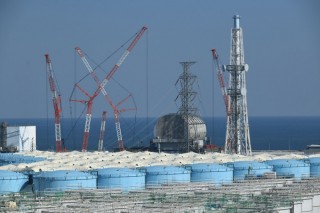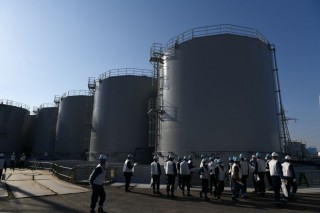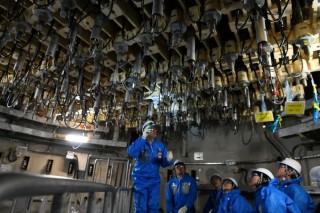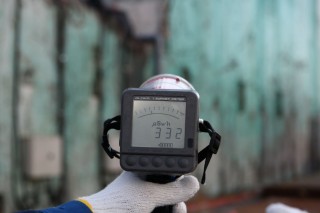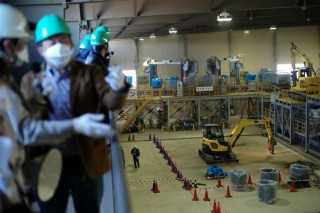Loading
Search
▼ Eight Years After Triple Meltdown, Fukushima No. 1's Water Woes Slow To Recede
- Category:Other
This is the first in a series examining how the northeast and the nation are progressing with efforts to deal with the March 2011 earthquake, tsunami and nuclear crisis.
OKUMA, FUKUSHIMA PREF. - Nearly a thousand storage tanks are scattered across the Fukushima No. 1 nuclear power plant, holding a staggering 1.1 million tons of treated water used to keep its melted reactor cores cool while they rust in the sun.
Plant manager Tokyo Electric Power Company Holdings Inc., or Tepco, plans to build more of the gigantic tanks to hold another 0.27 million tons, which is roughly the equivalent of 108 Olympic-size swimming pools. The new tanks are expected reach full capacity in four or five years.
Each tank takes seven to 10 days to fill and holds between 1,000 to 1,200 tons of liquid, Tepco officials told reporters during a tour in February organized by the Japan National Press Club. It’s been eight years since Fukushima No. 1 suffered three core meltdowns triggered by tsunami following the Great East Japan Earthquake, but the situation with the tanks may be a sign Tepco has yet to get the facility under control.
“Space isn’t a big issue at this point in time, but five or 10 years from now, after we’ve started removing the melted fuel debris, we’re going to need facilities to store and preserve it,” Akira Ono, president of Fukushima No. 1 Decontamination and Decommissioning Engineering Co., a Tepco unit overseeing the decommissioning process, said at a news conference in January.
The water issue is eating up both space and resources, but a solution is unlikely to emerge anytime soon.
The International Atomic Energy Agency published a report in November that said the physical constraints of the site “leave little room for additional tanks” beyond what Tepco has allocated.
The IAEA report went on to say it believes storing tainted water in “above ground tanks . . . can only be a temporary measure while a more sustainable solution is needed” and a “decision on the disposition path should be taken urgently.”
Beyond 2020, Tepco has not allocated any additional space for holding treated water on the site and has no plans to do so at this time. The utility said the tanks will likely become a headache if they remain at the plant.
“At that point, we may need to rethink how we’re using the space,” Ono said.
Eight years ago when the monstrous tsunami hit, the entire plant lost power and reactors 1, 2 and 3 lost coolant, causing their cores to overheat. The fuel rods consequently melted, dripping molten fuel that burned through their pressure vessels and pooled in their primary containment vessels. Reactors 1, 3 and 4 then suffered hydrogen explosions.
Tepco must inject water into the reactors indefinitely to keep the melted cores cool, but water tainted by contact with the fuel and associated debris has been leaking from the damaged containment vessels and into the basements of the reactor buildings, where tons of fresh groundwater flows in daily through holes in their damaged walls.
The contaminated water is pumped out and passed through a filtration device called the Advanced Liquid Processing System — which is supposed to remove every radionuclide except for tritium — and stored in the tanks.
Tepco has taken steps to limit the amount
of groundwater seeping into the reactor buildings, including wells to intercept and divert it and an underground ice wall around the buildings to block any inflow.
According to Tepco, however, about 83 tons of water are seeping into the reactor buildings each day. Although this is an improvement from some 300 tons in previous years, Tepco must keep making more tanks.
At the moment, Tepco is waiting for a government panel’s advice on what to do with the tritium-tainted water. The panel is considering five disposal methods: ground injection, sea discharge after diluting the tritium concentration, discharging it as steam, discharging it as hydrogen, and solidification followed by underground burial.
Tritium is a radioactive form of hydrogen that forms naturally and is a common byproduct of nuclear reactors. In large quantities, exposure can be dangerous, especially if ingested or inhaled.
Processed adequately, however, tritium is believed to pose little to no health risk. For instance, tritium is present in regular tap water, but no ill effects have been confirmed, according to the Ministry of Economy, Trade and Industry.
“At that point, we may need to rethink how we’re using the space,” Ono said.
Eight years ago when the monstrous tsunami hit, the entire plant lost power and reactors 1, 2 and 3 lost coolant, causing their cores to overheat. The fuel rods consequently melted, dripping molten fuel that burned through their pressure vessels and pooled in their primary containment vessels. Reactors 1, 3 and 4 then suffered hydrogen explosions.
Tepco must inject water into the reactors indefinitely to keep the melted cores cool, but water tainted by contact with the fuel and associated debris has been leaking from the damaged containment vessels and into the basements of the reactor buildings, where tons of fresh groundwater flows in daily through holes in their damaged walls.
The contaminated water is pumped out and passed through a filtration device called the Advanced Liquid Processing System — which is supposed to remove every radionuclide except for tritium — and stored in the tanks.
Tepco has taken steps to limit the amount
of groundwater seeping into the reactor buildings, including wells to intercept and divert it and an underground ice wall around the buildings to block any inflow.
According to Tepco, however, about 83 tons of water are seeping into the reactor buildings each day. Although this is an improvement from some 300 tons in previous years, Tepco must keep making more tanks.
At the moment, Tepco is waiting for a government panel’s advice on what to do with the tritium-tainted water. The panel is considering five disposal methods: ground injection, sea discharge after diluting the tritium concentration, discharging it as steam, discharging it as hydrogen, and solidification followed by underground burial.
Tritium is a radioactive form of hydrogen that forms naturally and is a common byproduct of nuclear reactors. In large quantities, exposure can be dangerous, especially if ingested or inhaled.
Processed adequately, however, tritium is believed to pose little to no health risk. For instance, tritium is present in regular tap water, but no ill effects have been confirmed, according to the Ministry of Economy, Trade and Industry.
Discharging treated tritium water into the ocean is a common practice at nuclear power plants around the world.
Thus some experts, including Toyoshi Fuketa, who heads the Nuclear Regulation Authority, think this is the best option for Fukushima.
“Prolonging the storage of water in those tanks will make decommissioning the power plant that much more difficult for Tepco. Limited resources are being used to use these tanks as storage, not just money but other resources as well,” Fuketa said at a news conference in September.
“The longer we store the water, the greater the influence it will have on the decommissioning of the Fukushima No. 1 power plant.”
But there are concerns about the impact an ocean discharge may have on fisheries still trying to recover from the nuclear crisis.
Fishing in the area has resumed on a trial basis and workers still perform radiation checks before shipping their hauls to fish markets. The waters off Fukushima Prefecture are at the confluence of two ocean currents — the Oyashio from the north and Kuroshio from the south — which make for the good fishing grounds that have been a vital part of the agrarian prefecture’s economy.
Eight years after the meltdowns, however, residents are still struggling to convince the world that fish from the area are safe to eat. Many believe public perception alone will cripple Fukushima’s fishing industry anew if the tainted water is expelled into the ocean — even if the tritium has been reduced to below international standards.
Trust issues continue to plague Tepco after it claimed ALPS was filtering every radionuclide from the cooling water except tritium. Last August it came to light that the allegedly treated water still contained other dangerous contaminants, including iodine, cesium and strontium. Some of the concentrations were above current safety limits.
Thus some experts, including Toyoshi Fuketa, who heads the Nuclear Regulation Authority, think this is the best option for Fukushima.
“Prolonging the storage of water in those tanks will make decommissioning the power plant that much more difficult for Tepco. Limited resources are being used to use these tanks as storage, not just money but other resources as well,” Fuketa said at a news conference in September.
“The longer we store the water, the greater the influence it will have on the decommissioning of the Fukushima No. 1 power plant.”
But there are concerns about the impact an ocean discharge may have on fisheries still trying to recover from the nuclear crisis.
Fishing in the area has resumed on a trial basis and workers still perform radiation checks before shipping their hauls to fish markets. The waters off Fukushima Prefecture are at the confluence of two ocean currents — the Oyashio from the north and Kuroshio from the south — which make for the good fishing grounds that have been a vital part of the agrarian prefecture’s economy.
Eight years after the meltdowns, however, residents are still struggling to convince the world that fish from the area are safe to eat. Many believe public perception alone will cripple Fukushima’s fishing industry anew if the tainted water is expelled into the ocean — even if the tritium has been reduced to below international standards.
Trust issues continue to plague Tepco after it claimed ALPS was filtering every radionuclide from the cooling water except tritium. Last August it came to light that the allegedly treated water still contained other dangerous contaminants, including iodine, cesium and strontium. Some of the concentrations were above current safety limits.
This has further angered Fukushima residents and made it harder to get their approval for dumping the water held by the tanks into the sea.
During a public hearing hosted by METI in August, participants urged the government and Tepco to consider finding an off-site location to store the water instead of discharging it into the ocean.
“Without a national debate and without the understanding of Japanese citizens or the countries importing our products, as a fisherman of Fukushima Prefecture, I strongly oppose the plan to discharge the treated water into the ocean,” Tetsu Nozaki, chairman of the Fukushima Prefectural Federation of Fisheries Cooperative Association, told the hearing.
“To release the ALPS-treated water into the ocean, at this time, would deal a disastrous blow to the fishermen of Fukushima and rob them of their hard work and motivation,” he said.
Thierry Charles, deputy director-general in charge of nuclear safety at the Radioprotection and Nuclear Safety Institute in France, admitted it is a difficult problem to address, given the volume of water concerned and the tritium content.
Charles believes a controlled release into the ocean would be viable “under conditions to be defined.”
“In this respect, the societal acceptance of this solution should be based on the broad involvement of all stakeholders at the various stages of the process, by explaining the different options studied,” he told The Japan Times.
Meanwhile, the crippled plant faces other serious challenges — including how to extract the molten fuel.
“How we remove the melted fuel debris from the reactors. That’s the most important point. . . . The water tanks are not a big problem,” said Hiroshi Miyano, a professor at Hosei University’s Graduate School of Engineering and Design and chair of the decommissioning committee of the Atomic Energy Society of Japan.
During a public hearing hosted by METI in August, participants urged the government and Tepco to consider finding an off-site location to store the water instead of discharging it into the ocean.
“Without a national debate and without the understanding of Japanese citizens or the countries importing our products, as a fisherman of Fukushima Prefecture, I strongly oppose the plan to discharge the treated water into the ocean,” Tetsu Nozaki, chairman of the Fukushima Prefectural Federation of Fisheries Cooperative Association, told the hearing.
“To release the ALPS-treated water into the ocean, at this time, would deal a disastrous blow to the fishermen of Fukushima and rob them of their hard work and motivation,” he said.
Thierry Charles, deputy director-general in charge of nuclear safety at the Radioprotection and Nuclear Safety Institute in France, admitted it is a difficult problem to address, given the volume of water concerned and the tritium content.
Charles believes a controlled release into the ocean would be viable “under conditions to be defined.”
“In this respect, the societal acceptance of this solution should be based on the broad involvement of all stakeholders at the various stages of the process, by explaining the different options studied,” he told The Japan Times.
Meanwhile, the crippled plant faces other serious challenges — including how to extract the molten fuel.
“How we remove the melted fuel debris from the reactors. That’s the most important point. . . . The water tanks are not a big problem,” said Hiroshi Miyano, a professor at Hosei University’s Graduate School of Engineering and Design and chair of the decommissioning committee of the Atomic Energy Society of Japan.
In February, Tepco inserted a remote-controlled probe into reactor 2 to make contact with material inside the containment vessel believed to be melted fuel. The machine — equipped with a camera, thermometer and dosimeter — was designed to poke and gently lift sediment to test its physical properties.
This was the first time a machine had touched melted fuel debris inside any of the crippled reactors at Fukushima No. 1.
The removal process at the plant is slated to begin in 2021. Before that part begins, though, research from the site will be used to make various remote-controlled probes capable of navigating the unique scenarios in each unit. Reactor 3, for example, remains largely submerged and requires an aquatic probe.
Miyano said Tepco and the government — with the help of scientists, nuclear physicists and engineers from around the world — are inventing new technologies as they devise a way to remove the debris.
He added that no country has ever attempted to use remote-controlled robots to remove melted fuel from the inside of a crippled nuclear reactor.
“This is the first time, so there will be many challenges.”
This was the first time a machine had touched melted fuel debris inside any of the crippled reactors at Fukushima No. 1.
The removal process at the plant is slated to begin in 2021. Before that part begins, though, research from the site will be used to make various remote-controlled probes capable of navigating the unique scenarios in each unit. Reactor 3, for example, remains largely submerged and requires an aquatic probe.
Miyano said Tepco and the government — with the help of scientists, nuclear physicists and engineers from around the world — are inventing new technologies as they devise a way to remove the debris.
He added that no country has ever attempted to use remote-controlled robots to remove melted fuel from the inside of a crippled nuclear reactor.
“This is the first time, so there will be many challenges.”
- March 8, 2019
- Comment (0)
- Trackback(0)


